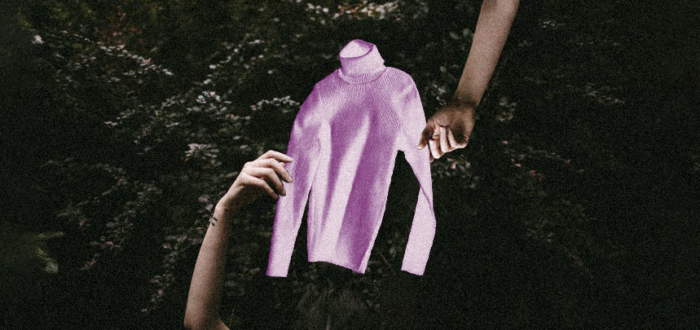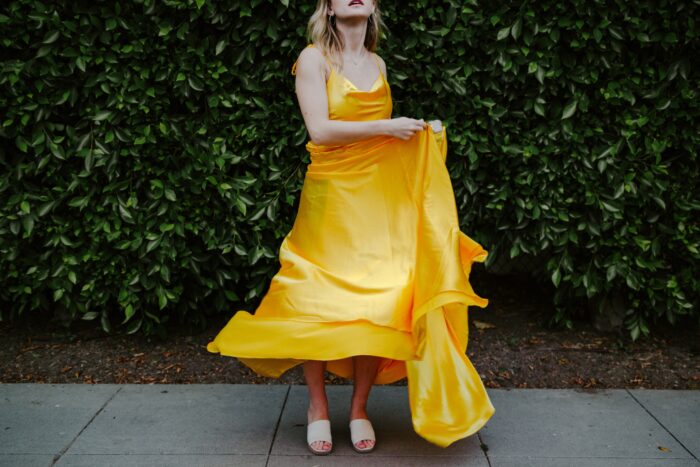Dopamine Dressing and Loved Clothes Last
Exploring the link between the trend of Dopamine Dressing and our Loved Clothes Last movement.
Introduced as one of the biggest trends for 2022, “Dopamine Dressing” has been seen everywhere, invigorating the SS22 catwalks and dominating the streets during Fashion Week. Propelled by a desire for positivity and better well-being after the pandemic, dopamine dressing involves dressing with intention to boost your mood and bring joy, defined by vibrant colours and cheerful patterns. But it is nothing new to suggest that fashion has the power to brighten your day; it is well known that colours, styles, and textures all have psychological associations and can often be tied to memories, creating a connection between our outfits and our state of mind.

The psychological affects of clothing
Clothing is connected to happiness for a lot of people. This is why retail therapy is so prolific and the fast fashion model of constant new-ness has dominated our consumption habits. The growth of fast fashion and material obsession within our society has created the illusion that to be fashionable is to be excessive, and that in order to be satisfied, we need to keep pace with the rapidly changing trends. However, constantly buying new products leaves us disempowered; physical goods cannot truly satisfy our emotional needs.
When people go shopping, consumption is not driven by a desire for more material goods but from an attempt to satisfy our needs. With each new item comes a novel experience, a burst of dopamine and a rush of excitement; but the crash afterwards hits harder. Fashion connects us with our emotional expression, and clothes can foster our needs for affection, identity, and creation. If these needs are being met by impulse buys and short-lived satisfaction, we become stuck in the endless cycle of shopping, desperate for the next hit of happiness.

Overconsumption
We know that this excessive consumption is damaging to our planet and has enormous negative social impacts. Yet the cycle persists, creating with it a mountain of waste and un-loved clothes. A survey carried out by WRAP found that, in the UK, 26% of consumers reported that the reason behind the last item of clothing they threw away was because they simply didn’t like it anymore. We deem clothing to be disposable due to its low cost. We buy, we wear, we rip, we throw away. Many of us no longer feel motivated to value the things we buy, even less so to repair them when they start to fall apart. To break this pattern and transform the current industry, it is vital that we reevaluate our relationship with fashion. When it comes to shopping for and wearing clothes, our actions can change everything.

The value of our clothes
When envisioning a system in which quality is valued over quantity, understanding the value and emotional significance that fashion brings to people becomes crucial. Everyone is connected to the clothes they wear; it’s why we all have garments hanging at the back of our wardrobes that we haven’t worn in years but just can’t part with. But we shouldn’t over look the clothes we wear everyday either.
In her thesis, Stories Clothes Tell: Investigating Clothing as Objects of Love, Isabel Mundigo-Moore looks to the mundane as a place to create space for alternative narratives, challenging people to view worn clothing as objects of love and embrace the radical power of finding love stories in everyday dress, a sentiment echoed by our Loved Clothes Last campaign. To truly cherish the clothing we collect, we need to nurture a deep understanding of our connection to fashion, looking beyond the superficial and materialistic to see the layers of life events, people, feelings, and memories that lie within our clothes. By doing so, we can begin to create more meaningful, lasting connections with fashion.

Dressing for happiness
While the current trend of “dopamine dressing” is characterised by its rainbow hues and clashing prints, the sentiment behind the style is much more diverse. Within colour psychology, there are strong connections between certain shades and their mood-boosting qualities; the enduring association of happiness with the colour yellow is a prime example. But what feels good to one person won’t necessarily feel the same for another. This is because we all have our own symbolic associations with colours, styles and textures, based our own lived experiences and unique psychological make-up. We’ve all felt that rush of confidence when we put on our favourite clothes, even if the colours are muted and the design simple.
Ultimately, “dopamine dressing” isn’t anything new, it is simply the natural result of good clothes, of having a strong sense of personal style and dressing in alignment with yourself and your values. Question why you feel compelled to shop, and try to identify the signs you are buying something impulsively. We have to become more mindful of our shopping habits and consider the future of our garments. To truly create a positive relationship with fashion, it is essential that we find value within the beautiful stories behind our clothes.
Further Reading:
Care, Rewear & Repair to Transform the Fashion System by The Restory
The Rise of Generation Conscious by Victoria Prew
References:
D. Soron, 2010 – Sustainability, self-identity and the sociology of consumption
WRAP, 2016 – Measuring the active life of clothing
Fashion Revolution – Loved Clothes Last Zine
Williams D., N. Baldwin, and K. Fletcher. 2009 – Center for sustainable fashion: tactics for change
I. Mundigo-Moore – Stories Clothes Tell: Investigating Clothing as Objects of Love
A. Maldonado, 2021 – What is Dopamine Dressing?
Header Image / Designer: Joao Maraschin / Photographer: Laura Aguilera








